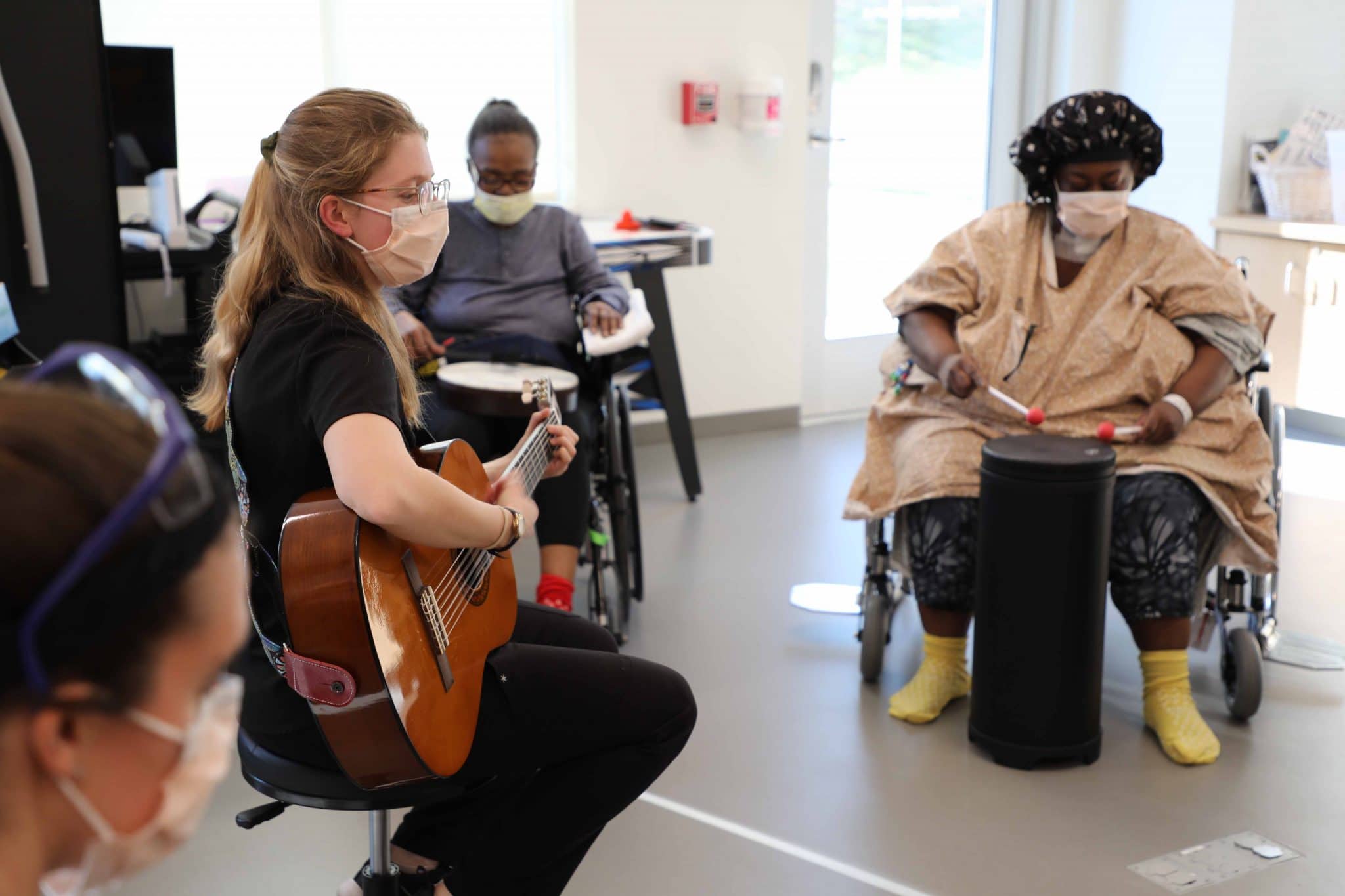Home>Events & Info>Music Therapy>How Do You Do Music Therapy


Music Therapy
How Do You Do Music Therapy
Modified: February 2, 2024
Immerse yourself in the healing power of music therapy. Discover how music can improve your well-being and transform your life. Learn more about the benefits of music therapy today.
(Many of the links in this article redirect to a specific reviewed product. Your purchase of these products through affiliate links helps to generate commission for AudioLover.com, at no extra cost. Learn more)
Table of Contents
Introduction
Welcome to the world of music therapy, an innovative and impactful approach to healing and well-being. Music therapy harnesses the power of music to address various physical, emotional, and cognitive needs of individuals. It is a dynamic and evidence-based practice that has gained recognition and popularity in recent years.
Music therapy is much more than just listening to pleasant melodies; it is a targeted intervention that utilizes music-based techniques to address specific goals and objectives. Whether it is reducing stress and anxiety, enhancing communication and social skills, managing pain, or improving cognitive function, music therapy has proven to be a valuable tool in promoting overall wellness and quality of life.
Music has the ability to evoke strong emotions and memories, and it can serve as a powerful medium of expression and communication, transcending language and cultural barriers. This makes it a versatile and inclusive therapeutic approach that can benefit people of all ages and abilities.
In this article, we will delve into the fascinating world of music therapy, exploring the techniques used, the conditions it can help with, and the steps to becoming a music therapist. Whether you are a music lover curious about its therapeutic potential, a healthcare professional seeking alternative modalities, or someone looking for a new career path, this article will provide you with a comprehensive understanding of music therapy and its applications.
Get ready to embark on a journey that combines the beauty of music with the healing power of therapy. Let’s explore the exciting realm of music therapy together!
What is Music Therapy?
Music therapy is a specialized form of therapy that uses music to address the physical, emotional, cognitive, and social needs of individuals. It is an evidence-based practice that is conducted by trained music therapists who have extensive knowledge of music and its therapeutic applications.
At its core, music therapy involves the intentional use of music to achieve therapeutic goals. It goes beyond simply listening to music and encompasses a wide range of activities and techniques that are tailored to meet the specific needs of each individual. Sessions may involve singing, playing instruments, improvisation, composing, movement to music, and listening exercises.
Music therapists are skilled in creating a safe and supportive environment where individuals can freely express themselves through music. By engaging in musical experiences, clients are encouraged to explore and process their emotions, develop coping mechanisms, improve communication and social skills, enhance self-awareness, and manage physical and emotional pain.
Music therapy can be conducted in various settings, including hospitals, rehabilitation centers, schools, mental health facilities, and community centers. It can be delivered on an individual basis or in a group setting, depending on the needs and preferences of the client.
It is important to note that music therapy is not the same as music entertainment or music education. While music can provide enjoyment and learning opportunities, music therapy is specifically focused on therapeutic outcomes and is guided by a trained professional who tailors the interventions to the needs of the individual.
Research has shown that music therapy has numerous benefits across different populations and settings. It can help reduce anxiety and stress, improve mood and emotional well-being, enhance cognitive function, promote relaxation, support pain management, and facilitate communication and social interaction.
Overall, music therapy harnesses the innate power of music to promote healing, personal growth, and well-being. It provides individuals with a unique and creative pathway for expression, exploration, and transformation. Whether used as a standalone therapy or as a complementary approach alongside other treatments, music therapy has the potential to make a profound impact on the lives of individuals.
Benefits of Music Therapy
Music therapy offers a wide range of benefits for individuals of all ages and abilities. It is a versatile and holistic approach that can address physical, emotional, cognitive, and social needs. Here are some of the key benefits of music therapy:
- Reduces stress and anxiety: Music has a soothing effect on the mind and body, helping to decrease stress and anxiety levels. Listening to calming music or engaging in musical activities can promote relaxation and provide a sense of comfort and peace.
- Improves mood and emotional well-being: Music has the power to uplift our spirits and evoke a wide range of emotions. In music therapy, individuals can explore and express their emotions through music, which can lead to increased self-awareness and improved emotional well-being.
- Enhances cognitive function: Music stimulates cognitive processes such as memory, attention, and problem-solving. Engaging in musical activities can help improve cognitive abilities, enhance focus and concentration, and promote mental agility.
- Supports pain management: Music therapy has been shown to have a positive impact on pain management. Listening to music or actively participating in musical activities can distract individuals from pain, promote relaxation, and release endorphins, which are natural painkillers.
- Fosters communication and socialization: Music has a universal language that transcends barriers and promotes communication and socialization. In music therapy sessions, individuals can engage in musical interactions, such as singing, playing instruments, or engaging in improvisation, which can improve communication skills and foster social connections.
- Enhances physical rehabilitation: Music therapy can be utilized to support physical rehabilitation efforts. Rhythmic music can aid in motor coordination and movement, while songs with specific rhythms and beats can help regulate breathing and heart rate.
- Boosts self-esteem and self-expression: Music therapy provides a safe and non-judgmental space for individuals to express themselves creatively. Through musical activities, individuals can gain a sense of accomplishment, improve self-esteem, and develop a positive self-image.
- Promotes overall well-being and quality of life: By addressing various needs and providing a multi-dimensional experience, music therapy contributes to overall well-being and an improved quality of life. It enhances individuals’ sense of purpose, connection, and enjoyment, leading to a more fulfilling and meaningful existence.
These are just a few of the many benefits that music therapy can offer. The beauty of music therapy is its adaptability and individualized approach, where interventions are tailored to meet the unique needs and goals of each person. Whether used as a standalone therapeutic modality or in conjunction with other treatments, music therapy has the potential to make a significant impact on the lives of individuals.
Techniques Used in Music Therapy
Music therapy utilizes a variety of techniques to meet the specific therapeutic goals of individuals. These techniques are carefully selected and tailored by music therapists based on their assessment of the client’s needs and preferences. Here are some commonly used techniques in music therapy:
- Active music making: This technique involves actively engaging clients in music-making activities such as playing instruments, singing, and improvisation. Through these activities, individuals can express themselves, develop fine motor skills, and experience a sense of accomplishment.
- Music listening: Listening to music can have powerful emotional and physiological effects. In music therapy, specific songs or genres of music are chosen to elicit desired responses and emotions. Therapists may use music to promote relaxation, encourage reflection, or evoke specific memories and emotions.
- Songwriting: Songwriting allows individuals to express their thoughts, emotions, and experiences through the creation of original songs. This process can be therapeutic and empowering, helping individuals to gain insights, process emotions, and develop a sense of identity and self-expression.
- Musical improvisation: Improvisation involves creating music spontaneously without predefined structures or rules. Improvisation can be done individually or in a group setting and allows individuals to explore their creativity, enhance communication and self-expression, and build social connections through musical interactions.
- Movement to music: Incorporating movement into music therapy sessions can facilitate physical coordination, stimulate the senses, and promote emotional and cognitive engagement. Clients may engage in activities such as dancing, rhythmic movement, or using scarves or props to enhance their connection with the music.
- Guided imagery: Guided imagery uses music as a background while individuals engage in visualization exercises guided by the therapist’s voice. This technique can help individuals relax, reduce anxiety, and tap into their imagination and inner resources for healing and self-discovery.
- Music-assisted relaxation: Music can be used as a tool to induce relaxation and support stress reduction. Therapists may use calming and soothing music, combined with breathing exercises or muscle relaxation techniques, to help individuals achieve a state of deep relaxation and tranquility.
- Therapeutic singing: Singing can be a powerful tool for self-expression and emotional release. Therapists may encourage clients to sing songs that resonate with their experiences and emotions, using vocal techniques to support the therapeutic process.
These techniques are tailored to suit the unique needs and goals of each individual. The beauty of music therapy is that the therapist can adapt and modify the techniques based on the client’s response and progress, ensuring a personalized and effective therapeutic experience.
How Does Music Therapy Work?
Music therapy works by harnessing the power of music to create a therapeutic and healing experience for individuals. It combines the emotional, cognitive, physical, and social benefits of music to address various needs and promote well-being. Here is a closer look at how music therapy works:
Emotional engagement and expression: Music has the ability to evoke and express emotions in a powerful and direct way. Through music therapy, individuals are encouraged to engage with music on an emotional level, allowing them to explore and express their feelings. This emotional engagement can lead to increased self-awareness, emotional release, and a sense of validation and understanding.
Stress reduction and relaxation: Listening to soothing music or engaging in musical activities can have a calming and relaxing effect on the body and mind. Music therapy utilizes specific techniques to promote relaxation, reduce stress, and induce a state of physical and mental calmness. This can be particularly beneficial for individuals experiencing anxiety, tension, or difficulty in managing their stress levels.
Cognitive stimulation: Music can stimulate cognitive processes such as memory, attention, and problem-solving. Music therapy uses various techniques and exercises to engage the brain and enhance cognitive function. For example, playing an instrument or learning new songs can improve memory and concentration, while improvisation exercises can boost creativity and cognitive flexibility.
Social interaction and communication: Music has a unique ability to facilitate social interaction and communication. In music therapy, individuals can engage in group music-making activities, which encourage collaboration, cooperation, and communication. The shared experience of creating music together can foster a sense of connection, build social skills, and promote a feeling of belonging and acceptance.
Physical rehabilitation and pain management: Music therapy can be effective in physical rehabilitation settings. Rhythmic music can assist in motor coordination and movement exercises, promoting physical rehabilitation and facilitating recovery. Additionally, listening to music or engaging in musical activities can distract individuals from pain, provide comfort, and aid in pain management.
Personal empowerment and self-expression: Music therapy provides individuals with a safe and supportive environment to express themselves and explore their own unique identities. Through music, individuals can gain a sense of control, empowerment, and self-worth. The creative self-expression that music therapy enables can foster personal growth, build self-confidence, and enhance self-esteem.
Therapeutic relationship: The therapeutic relationship between the music therapist and the client is a crucial element of music therapy. The therapist establishes a safe and trusting environment, allowing the client to feel comfortable and supported. Through active listening, empathy, and skillful interventions, the therapist guides the therapeutic process, tailoring the music-based interventions to the individual’s needs and goals.
Overall, music therapy works by tapping into the unique properties of music, including its emotional, cognitive, and social aspects, to facilitate healing, personal growth, and well-being. By engaging individuals in music-based experiences, music therapy provides a transformative and enriching avenue for self-expression, connection, and healing.
Music Therapy Approaches
Music therapy encompasses a variety of approaches and methodologies that are tailored to the specific needs of each individual. Different approaches may be employed based on the goals of the therapy and the preferences of the client. Here are some common music therapy approaches:
Receptive Music Therapy: This approach involves listening to music, either passively or actively. The music therapist selects specific songs or compositions to evoke certain emotions or memories, and the individual engages in reflective or contemplative exercises while listening. Receptive music therapy can be particularly effective in promoting relaxation and emotional healing.
Active Music Making: This approach involves active participation in musical activities such as singing, playing instruments, and improvisation. The therapist may guide the individual in creating and performing music, enabling self-expression and emotional release. These active music-making sessions can be empowering and facilitate personal growth and development.
Nordoff-Robbins Music Therapy: Developed by Paul Nordoff and Clive Robbins, this approach focuses on improvisation as a means of creative expression and communication. The therapist improvises music in response to the client’s gestures and vocalizations, facilitating a musical dialogue and fostering emotional connection and development.
Orff-Schulwerk Music Therapy: Based on the educational approach developed by Carl Orff and Gunild Keetman, this approach emphasizes creativity and playfulness. It utilizes rhythmic activities, percussive instruments, and movement to music as a means of self-expression, social interaction, and skill development.
Psychodynamic Music Therapy: This approach integrates psychodynamic principles with music therapy techniques. The therapist explores unconscious processes and emotional experiences through music, helping the individual gain insights into their thoughts, feelings, and relationships. The aim is to promote self-awareness, emotional growth, and psychological healing.
Neurologic Music Therapy: This approach focuses on utilizing the brain’s innate response to music to address cognitive, motor, and speech goals. Therapists use specific music interventions to stimulate different regions of the brain, promoting neuroplasticity and facilitating functional improvements. Neurologic music therapy is often used in rehabilitation settings for individuals with neurological conditions such as stroke or Parkinson’s disease.
It is important to note that these approaches are not mutually exclusive and can be combined to suit the individual’s needs. Music therapists are trained in assessing clients and tailoring interventions that draw from different approaches to create a personalized and effective therapy experience.
By employing these various approaches, music therapists are able to cater to the unique needs, preferences, and goals of each individual. Whether it is through receptive listening, active music making, or other specialized techniques, music therapy approaches provide a diverse range of options to facilitate healing, self-expression, and personal growth.
Conditions and Disorders Treated with Music Therapy
Music therapy has been found to be effective in addressing a wide range of conditions and disorders across different populations. It can be utilized as a primary or complementary therapeutic modality in various healthcare settings. Here are some of the conditions and disorders that can be treated with music therapy:
- Autism Spectrum Disorder (ASD): Music therapy can help individuals with ASD improve social interaction, communication, and emotional regulation. The structured nature of music and the use of visual aids can enhance engagement and facilitate positive behavioral changes.
- Depression and Anxiety: Music therapy has shown to be beneficial in reducing symptoms of depression and anxiety. Engaging in musical activities can improve mood, promote relaxation, and provide a healthy outlet for emotional expression.
- Dementia and Alzheimer’s Disease: Music therapy can have a profound impact on individuals with dementia or Alzheimer’s disease. Listening to familiar music from their past can evoke memories, reduce agitation, and promote emotional well-being.
- Chronic Pain: Music therapy has been effective in managing chronic pain by distracting individuals from their discomfort, promoting relaxation, and enhancing mood. Listening to soothing music or engaging in musical activities can help reduce pain perception and improve overall quality of life.
- Speech and Language Disorders: Music therapy can assist in improving speech and language skills in individuals with communication disorders. Singing and rhythmic patterns in music can help facilitate speech production, enhance articulation, and improve fluency.
- Developmental Disabilities: Music therapy can support individuals with developmental disabilities in areas such as communication, sensory integration, motor skills, and social interaction. The structured nature of music and the use of visual aids can promote cognitive and physical development.
- Stress-related Disorders: Music therapy is effective in reducing stress and promoting relaxation. It can be beneficial in managing stress-related disorders such as post-traumatic stress disorder (PTSD) and stress-induced physiological conditions.
- Physical Rehabilitation: Music therapy is often used in rehabilitation settings to aid in motor coordination, balance, and physical rehabilitation. Rhythmic music can help promote movement and stimulate the brain and nervous system.
It is important to note that music therapy is a customizable and adaptable approach that can be tailored to address the individual needs of each client. Music therapists work closely with clients, assessing their specific conditions and goals to design interventions that are effective and meaningful.
While music therapy does not claim to cure medical conditions or disorders, it can significantly enhance the therapeutic process and improve the overall well-being and quality of life for individuals facing various challenges.
Music Therapy in Different Settings
Music therapy can be implemented in a variety of settings to cater to the diverse needs of individuals and communities. Here are some of the key settings where music therapy is often used:
- Hospitals: Music therapy is commonly integrated into healthcare settings, including hospitals, to support patients in managing pain, reducing anxiety, and enhancing overall well-being. It can be used in surgical units, oncology departments, pediatric wards, and intensive care units, among others.
- Rehabilitation Centers: Music therapy plays a vital role in rehabilitation centers, assisting individuals recovering from physical injuries, strokes, or neurological conditions. It helps promote motor skills, communication, and emotional healing in the rehabilitation process.
- Schools: Music therapy is frequently incorporated into schools to support the educational and social-emotional needs of students. It can be utilized to enhance communication, self-expression, and academic skills, as well as to address behavioral challenges.
- Mental Health Facilities: Music therapy is effective in mental health settings, including psychiatric hospitals, outpatient clinics, and addiction treatment centers. It aids in managing symptoms of depression, anxiety, and trauma, while also promoting self-awareness, emotional regulation, and social interaction.
- Senior Care Facilities: Music therapy is widely used in nursing homes, assisted living facilities, and memory care units for older adults. It can enhance cognitive function, stimulate memories, and provide emotional support, improving overall quality of life for seniors.
- Community Centers: Music therapy is often accessible in community centers, providing therapeutic services to individuals outside of clinical or medical settings. This allows for a diverse range of individuals to access the benefits of music therapy, including those with limited resources or specific community needs.
- Special Education Centers: Music therapy is highly valued in special education settings, catering to the unique needs of individuals with developmental disabilities, learning disorders, or sensory processing difficulties. It can support communication, motor skills, social behavior, and academic progress.
Each setting presents unique opportunities and challenges, and music therapists adapt their techniques and interventions accordingly. Whether it is providing one-on-one sessions, group therapy, or community-based programs, music therapy professionals strive to create supportive and inclusive environments that harness the power of music to promote healing and well-being.
Moreover, music therapists collaborate with other healthcare professionals, educators, and caregivers to ensure a holistic and integrated approach to care. By working in different settings, music therapists contribute to improving the lives of individuals across diverse populations and enhancing overall community well-being.
Steps to Becoming a Music Therapist
If you have a passion for music and a desire to help others, a career in music therapy may be a perfect fit for you. Here are the steps to becoming a music therapist:
- Earn a Bachelor’s Degree: The first step is to complete a bachelor’s degree in music therapy or a related field from an accredited university. This degree program provides a solid foundation in music theory, psychology, counseling, and therapeutic techniques.
- Complete an Internship: After earning a bachelor’s degree, aspiring music therapists must complete a clinical internship. This internship provides hands-on experience under the guidance of a certified music therapist and allows students to apply their knowledge and skills in a professional setting.
- Obtain Board Certification: Upon completion of the internship, individuals can pursue board certification through the Certification Board for Music Therapists (CBMT). The board certification requires passing an exam that assesses knowledge and skills in the field of music therapy.
- Gain Professional Experience: After becoming board-certified, aspiring music therapists can begin their professional careers. They may work in hospitals, clinics, schools, or other healthcare or community settings to gain practical experience and further develop their skills.
- Seek Continuing Education: Music therapy is an evolving field, and it is important for music therapists to stay updated with the latest research, techniques, and practices. Continuing education programs, workshops, and conferences provide opportunities for professionals to expand their knowledge and expertise.
- Consider Advanced Certification: For music therapists who wish to specialize or advance their skills, there are options for advanced certifications in areas such as neurologic music therapy or palliative care. These certifications provide additional training and expertise in specific fields.
- Engage in Professional Organizations: Joining professional organizations, such as the American Music Therapy Association (AMTA) or regional music therapy associations, allows music therapists to connect with peers, access resources, and stay engaged in the field.
- Adhere to Ethical Standards: Music therapists are expected to maintain high ethical standards in their practice. They must follow the code of ethics established by professional organizations and ensure client confidentiality, professional conduct, and the well-being of their clients.
It is important to note that specific requirements for becoming a music therapist can vary by country and state. It is advisable to check the specific regulations and standards set by the professional organizations and licensing boards in your jurisdiction.
Becoming a music therapist is a rewarding and fulfilling career path that combines a passion for music with a desire to make a positive impact on individuals’ lives. With dedication, education, and practical experience, you can become a certified music therapist and embark on a meaningful journey of using music as a powerful tool for healing and well-being.
Conclusion
Music therapy is a powerful and impactful discipline that harnesses the healing power of music to address a wide range of physical, emotional, cognitive, and social needs. It offers individuals a unique and creative way to express themselves, process emotions, and achieve therapeutic goals.
Throughout this article, we have explored the various aspects of music therapy, including its definition, benefits, techniques, and applications. Music therapy has been found to be effective in treating conditions such as autism, depression, dementia, chronic pain, and speech disorders, among others.
Music therapy can be implemented in a variety of settings, including hospitals, rehabilitation centers, schools, mental health facilities, and senior care facilities. It is a flexible and adaptable approach, allowing therapists to tailor interventions to meet the unique needs and preferences of each individual.
Becoming a music therapist involves completing a bachelor’s degree, internships, and obtaining board certification. Continuing education and professional engagement are essential for staying current in the field and providing the best care for clients.
In conclusion, music therapy offers a dynamic and inclusive approach to healing and well-being. It taps into the universal language of music, utilizing its emotional, cognitive, and social benefits to create transformative experiences. Whether through listening, active music-making, or other specialized techniques, music therapy has the potential to make a profound impact on individuals of all ages and abilities.
So, whether you are a music enthusiast looking to explore the therapeutic potential of music, a healthcare professional seeking alternative approaches, or someone considering a career in music therapy, the journey into the realm of music therapy promises to be a fulfilling and enriching one. Discover the power of music as a catalyst for healing, growth, and meaningful connections through the beautiful practice of music therapy.











